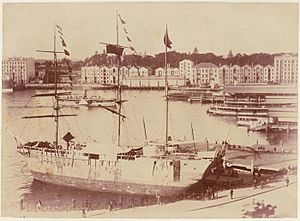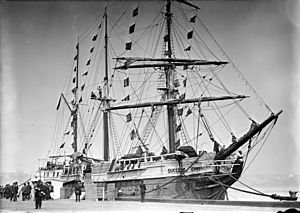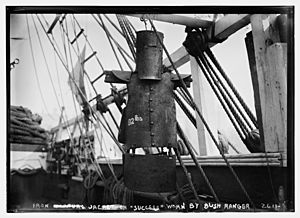Success (prison ship) facts for kids

The prison hulk, Success, at Hobart, Tasmania, Australia.
|
|
Quick facts for kids History |
|
|---|---|
| Name | Success |
| Completed | 1840 |
| Fate | Destroyed by fire in 1946 |
| General characteristics | |
| Tons burthen | 621 (bm) |
| Length | 117 ft 3 in (35.7 m) |
| Beam | 26 ft 6 in (8.1 m) |
| Draft | 22 ft 5 in (6.8 m) |
| Installed power | Sail |
| Sail plan | Full-rigged ship |
The Success was a ship built in 1840 in Myanmar (then called Burma). It was first used as a merchant ship, carrying goods and people. Later, it became a prison hulk in Australia. This meant it was a ship used as a floating prison. From the 1890s to the 1930s, the Success was turned into a museum ship. It traveled around the world, showing what life was supposedly like for convicts. In 1946, the ship was destroyed by a fire while it was docked in Lake Erie, near Cleveland, Ohio.
Contents
The Early Life of the Ship Success
The Success was a large merchant ship. It weighed 621 tons. It was about 117 feet long, 26 feet wide, and 22 feet deep. The ship was built in Natmoo, Burma, in 1840.
Trading and Carrying People
At first, the Success traded goods around India. Later, it was sold to owners in London, England. During the 1840s, it made three trips to Australia. On one trip, in 1849, the ship carried families who had survived the Great Famine. They arrived in Sydney just before Christmas.
Becoming a Prison Ship
In 1852, the Success arrived in Melbourne, Australia. Many of its crew members left the ship to join the Victorian gold rush. At this time, crime was increasing, and prisons were very full. The government of Victoria bought large sailing ships to use as prisons. These ships were called prison hulks. The Success was one of these ships.
In 1857, an event happened involving prisoners from the Success. The Superintendent of Prisons, John Price, was attacked. This event later inspired a character in a famous novel called For the Term of His Natural Life.
In 1854, the Success was changed again. It stopped being a prison ship and became a storage vessel. It stayed anchored on the Yarra River for the next 36 years.
The Success as a Museum Ship
In 1890, a group of business people bought the Success. They wanted to turn it into a museum ship. Their plan was to travel the world and show people the supposed horrors of the convict era.
A Ship with a New Story
The Success was never actually a convict ship. However, it was advertised as one. Its real history was mixed up with other ships that had the same name. For example, a different ship named Success was used when Europeans first settled Western Australia. The museum ship Success was even incorrectly promoted as the oldest ship still floating. This was not true, as the USS Constitution, built in 1797, was older.
For its first public display in Sydney Harbour in 1891, a former prisoner named Harry Power worked as a guide. But the museum ship did not make much money. Its owners soon gave up and sank the ship in Kerosene Bay.
World Tours and Challenges
The next year, a new group of business people bought the sunken Success. They refloated it and fixed it up. The ship then toured cities like Brisbane, Adelaide, and Hobart in Australia. After that, it sailed to England, arriving in 1894.
In 1912, the Success crossed the Atlantic Ocean. It was shown as a convict museum along the east coast of the United States. It also visited ports on the Great Lakes. In 1915, the ship was docked in San Francisco for a big event called the Panama–Pacific International Exposition. A short film was even made on board, showing the mayor of San Francisco giving a tour.
For a short time in 1917, the Success was used to carry cargo again. In 1918, it sank after hitting ice. However, it was refloated again and went back to being a museum ship. In 1933, it was part of the Chicago World's Fair.
The Final Years of the Ship
Even with many repairs, the Success was getting old and unsafe to sail. It was towed to Sandusky, Ohio, on Lake Erie. The plan was to take it apart and sell it for scrap metal. But a strong storm sank the ship while it was docked there.
A salvage operator named Walter Kolbe later got the rights to the ship. In 1945, he had the Success towed to nearby Port Clinton. The port was too shallow, so the ship got stuck just east of Port Clinton. On July 4, 1946, a fire started on board the Success. It burned down to the waterline that afternoon. Many people watched the fire from the shore. It is believed that unknown vandals started the fire. Parts of the ship still remain in 16 feet of water east of Port Clinton harbor.
The South Australian Maritime Museum has a detailed model of the Success.




